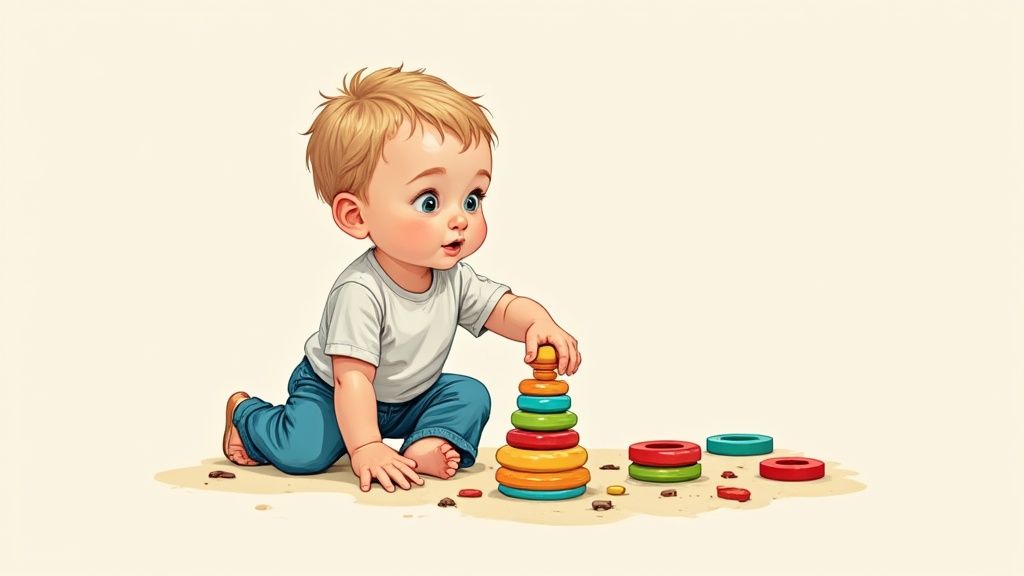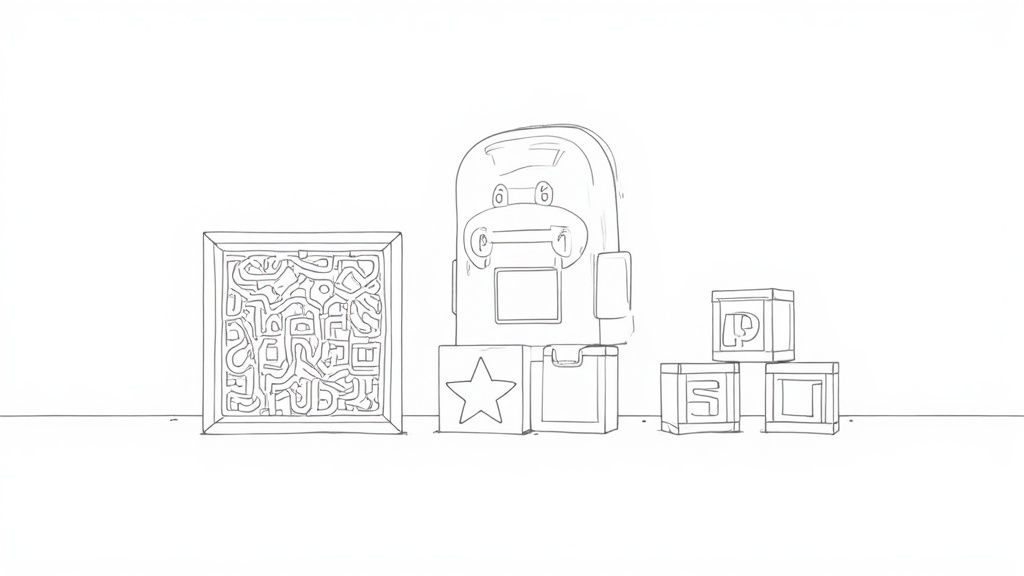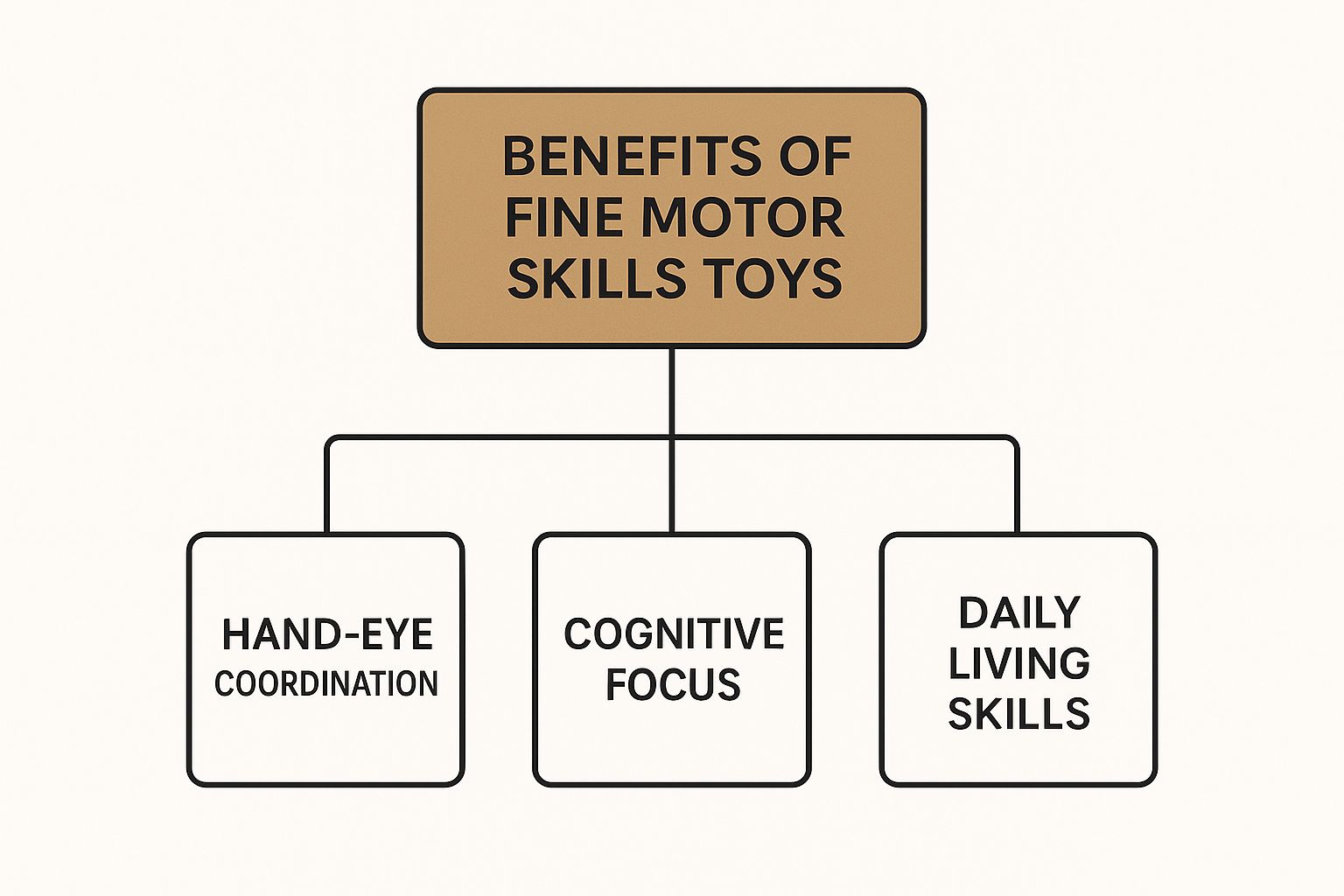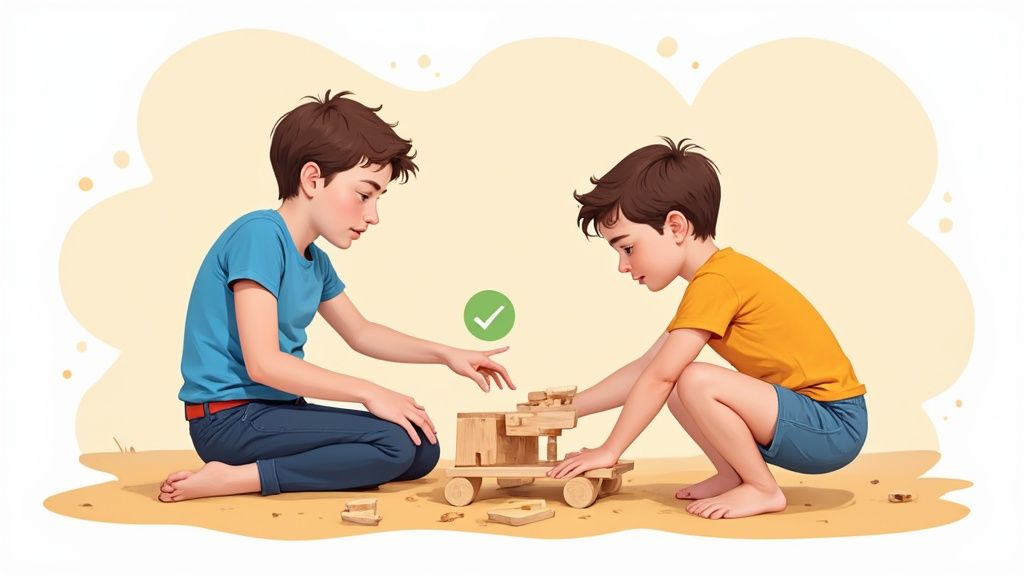Welcome to the wonderful world of little hands and big skills! Fine motor skills toys are so much more than just playthings; they're cleverly designed tools that help children build strength in the tiny muscles in their hands and fingers.
Think of them as the foundation for so many of life's essential tasks, from learning to write their name to the triumphant moment they finally tie their own shoelaces.
What Are Fine Motor Skills?

Right, let’s get straight to it. When we talk about ‘fine motor skills’, we’re simply talking about all those small, precise movements a child learns to do with their hands, fingers, and wrists. It’s the delicate pinch of a crayon, the careful twist of a bottle cap, or the steady hand needed to place one block on top of another.
These skills are the absolute cornerstones of a child's growing independence. They’re what allow our little ones to master everyday tasks, giving them that brilliant burst of confidence and self-reliance we all love to see.
Fine motor skills are all about the brain and muscles working together in harmony. They’re vital for succeeding at school and in daily life, helping children handle objects, use tools, and explore their world with confidence.
Consider this guide your friendly companion on this exciting journey. We’ve packed it with practical advice to help you understand, support, and choose the very best fine motor skills toys for your child. Our goal is to make you feel empowered and excited about watching your little one grow.
Why Play Is So Important
Play isn’t just fun and games; it’s a child’s most natural way of learning and practising these crucial abilities. When you see a child stacking blocks, threading beads, or concentrating on a puzzle, they're doing some serious work behind the scenes.
They are:
- Building Hand Strength: Every time they grip, squeeze, and manipulate a toy, they’re strengthening the very muscles needed for writing and using cutlery.
- Improving Hand-Eye Coordination: This is all about the eyes telling the hands what to do. It’s the secret behind catching a ball or cutting along a line with scissors.
- Developing Dexterity: This is a fancy word for becoming skilful with their hands, especially for tasks that need a delicate, precise touch.
The focus on developmental play is really taking off. The United Kingdom's toy market was recently valued at around USD 3.91 billion, with a huge part of that growth coming from parents focusing more on childhood development.
Of course, it’s not just about what you can buy. You can also explore a whole range of fun fine motor skills development activities for kids that keep little hands busy and learning. Finding that perfect mix of structured play and everyday fun makes the whole process feel joyful and completely natural.
Why These Tiny Movements Make a Huge Difference

So, why do we make such a fuss about these tiny hand movements? It's because these small, careful actions unlock some of life’s biggest abilities. We're talking about so much more than just keeping your little one busy; this is the essential groundwork for their future confidence and independence.
Every time your child concentrates on stacking a block or threading a bead, they're training their brain and muscles to sync up. Think of it like a gymnast practising a routine—it's the same focused effort, just on a much smaller scale. These activities build hand strength, finger dexterity, and that all-important hand-eye coordination.
The Bridge to Academic Success
Believe it or not, a child's success in the classroom often starts on the playroom floor. Strong fine motor skills are a fantastic predictor of a child's readiness for school.
When a child has had plenty of practice with fine motor skills toys, they've already built up the control needed for all sorts of classroom tasks.
- Pencil Grip: Holding a pencil or crayon correctly and comfortably becomes second nature. This turns writing and drawing into a joy rather than a struggle.
- Scissor Skills: Cutting with scissors requires a whole set of coordinated movements, a skill they'll need for countless art projects.
- Concentration: The focus it takes to finish a puzzle or build a tower helps stretch their attention span, getting them ready for listening and learning in class.
Basically, all this "just playing" is the first step towards literacy and creativity. It builds a solid foundation long before they ever sit down at a school desk.
Investing in this kind of purposeful play now pays huge dividends later on. It’s not just about learning to write their name; it’s about giving them the physical tools and confidence to tackle new challenges head-on.
Fostering Everyday Independence
Beyond school, these skills are absolutely vital for self-care. The journey to independence is paved with small, triumphant moments made possible by well-developed fine motor control.
Each little accomplishment, no matter how minor it seems to us, is a massive boost to their self-esteem. It's that proud "I did it myself!" moment that every parent loves to hear. This growing ability lets them take real ownership of their daily routines.
Just think about these everyday victories:
- Dressing Themselves: Zipping up a jacket, fastening buttons, and eventually, tying their own shoelaces.
- Mealtime Mastery: Holding a fork and spoon properly to feed themselves without a helping hand.
- Personal Care: Squeezing toothpaste onto a brush or opening their own lunchbox.
By giving them plenty of chances to practise these skills with engaging toys, you’re empowering your child to become more and more self-reliant. To see some great options, explore our handpicked collection of best sellers to find toys that make this crucial practice feel like pure fun.
Choosing the Best Fine Motor Toys for Every Age
Alright, let's get down to the fun part! Picking the right toy for your child's specific stage of development can truly transform playtime. It turns simple fun into a powerhouse for learning, and we're here to help you choose with confidence.
Baby Steps: 0 to 12 Months
In that incredible first year, babies are on a massive journey of discovery. Their whole world revolves around learning to grasp, hold, and explore objects—mostly with their hands and, let's be honest, their mouths! They're moving from a simple reflex grasp to making deliberate, purposeful movements.
The best toys for this age are wonderfully simple, safe, and engaging. You're looking for things that are easy for tiny hands to clutch, shake, and investigate. Think soft textures, gentle rattling sounds, and bold, high-contrast colours that really capture their developing eyesight.
- Soft Blocks: Perfect for squeezing and attempting to stack. They build early hand strength without any sharp corners to worry about.
- Easy-to-Grasp Rattles: Lightweight rattles with interesting textures encourage babies to hold on tight, give them a good shake, and track the sound with their eyes.
- Textured Balls: A set of balls with different surfaces and sizes is fantastic. They invite batting, rolling, and eventually, that major milestone of passing a toy from one hand to the other!
This diagram shows just how these simple toys lay the groundwork for crucial skills.

As you can see, the right toys are about so much more than just keeping them busy; they directly support everything from hand-eye coordination to practical daily skills.
Toddler Triumphs: 1 to 3 Years
Welcome to the toddler years—a whirlwind of energy and boundless curiosity! At this age, children are busy refining their ability to grasp and release objects with intention. You'll see real determination as they try to make things work.
Their hand-eye coordination is improving by leaps and bounds, which means they're ready to tackle toys that demand a bit more precision. This is the prime time for stacking, sorting, and fitting pieces together. The key is to find that sweet spot: a challenge that keeps them engaged without causing a meltdown.
This stage is all about cause and effect. Toddlers are fascinated by seeing the direct result of their actions—whether it’s a tower crashing down or a shape finally clicking into its slot. This immediate feedback is how they learn.
Here are a few brilliant options for these busy little people:
- Chunky Puzzles: Simple puzzles with big, chunky knobs are fantastic for practising that all-important pincer grasp (using the thumb and forefinger).
- Stacking Rings and Cups: These classics are popular for a reason! They're brilliant for developing coordination and getting to grips with concepts like size and sequence.
- Large Building Blocks: Bigger blocks are ideal for small hands to stack, build, and, of course, knock down. This strengthens their grip and builds early spatial awareness.
Preschool Power: 3 to 5 Years
By the time they reach preschool age, children are becoming incredibly capable. Their fine motor skills are much more controlled, allowing them to take on complex tasks that require a steady hand and a good deal of concentration. They're getting ready for the fine motor demands of 'big school', like learning to write and use scissors.
Toys for this age can be more intricate, often featuring smaller parts and more detailed steps. It’s the perfect time to introduce activities that build up the endurance in their hand muscles and really let their creativity shine. For a fantastic selection, you can browse our full collection of fine motor toys.
If you’re looking for more inspiration, especially for construction play, check out this excellent guide on the best construction toys for 5 year olds.
- Lacing and Threading Toys: Pulling a lace through holes is a brilliant way to practise bilateral coordination (using both hands together) and work on precision.
- Construction Sets: Things like LEGO Duplo or magnetic tiles are excellent for building hand strength, encouraging problem-solving, and sparking imagination.
- Child-Safe Scissors and Play-Doh: These are the unsung heroes of fine motor development! Rolling, squeezing, and snipping all work the exact muscles needed for cutting and writing.
To make it even easier, here's a quick-reference table to guide your choices.
Fine Motor Toy Recommendations by Age
| Age Group | Key Motor Skills | Recommended Toy Examples |
|---|---|---|
| 0–12 Months | Grasping, holding, shaking, mouthing | Soft blocks, lightweight rattles, textured balls |
| 1–3 Years | Stacking, sorting, pincer grasp, twisting | Chunky puzzles, stacking rings, large building blocks |
| 3–5 Years | Cutting, threading, building, controlled drawing | Lacing beads, construction sets, play-doh, child-safe scissors |
This table is just a starting point, of course. The most important thing is to observe your child, see what sparks their interest, and provide playful opportunities that help them grow.
Creative Fun Beyond the Toy Box

You don’t always need to head to the toy shop to support your child's development. Believe it or not, your home is already a goldmine of simple items that can be transformed into fantastic fine motor skills toys with a bit of creativity.
Turning everyday routines and household objects into playful, skill-building moments is a brilliant way to encourage learning without any pressure. You'll be amazed at how easily these simple activities become powerful opportunities for growth.
Kitchen Creations and Crafty Fun
The kitchen is the heart of the home, and it’s also an amazing place for little hands to get busy. Simple tasks can build serious strength and coordination, all while making your child feel like a valued part of the family routine.
Next time you’re baking, let your little one help stir the mixture or knead the dough. These actions are fantastic for strengthening their hands and wrists. Even something as simple as using a spray bottle to water the plants builds the exact muscles they'll need later for using scissors.
Remember, it’s all about the process, not perfection. A bit of mess is a tiny price to pay for the huge developmental leaps your child is making by taking part in real-world activities with you.
Craft time is another brilliant opportunity. Instead of handing them a paintbrush, why not try a cotton bud for painting? This simple swap encourages a more refined pincer grip—the very same one they’ll eventually use to hold a pencil.
Playful Challenges with Household Items
You can create some really engaging games using things you've already got lying around. These low-cost (or no-cost!) activities challenge specific skills in a way that just feels like fun, which is perfect for keeping your child focused and motivated.
For instance, try hiding small, safe toys inside a ball of play-doh and letting your child "rescue" them. It’s a great workout for their little finger muscles! Or, give them some child-safe tweezers or tongs to sort dried pasta shapes into an ice cube tray, which is a wonderful task for building precision and hand-eye coordination. Even a classic multi-activity toy like the Classic World Large Multi-Activity Cube demonstrates how keeping activities varied holds a child's attention.
Here are a few more ideas to get you started:
- Pasta Threading: Grab some uncooked tube pasta (like rigatoni) and a shoelace or piece of string. Making necklaces is a superb activity for bilateral coordination—that's the skill of using both hands together to do different things.
- Sticker Rescue: Place stickers on a piece of paper or even on the back of their hand. Peeling them off is a fantastic way to practise that delicate pincer grasp.
- Clothespin Critters: Squeezing clothespins and attaching them to the edge of a piece of cardboard or a board book is a brilliant hand-strengthening exercise. Plus, they make great legs for animal drawings!
How to Choose the Right Fine Motor Toy
Right, so you're ready to find some brilliant toys? It can feel like a bit of a maze out there, but picking out great fine motor skills toys is actually much simpler than it looks. If you know what to look for, you can easily find toys that are both a huge hit with your child and fantastic for their development.
What Makes a Great Fine Motor Toy?
First things first: safety is everything. Especially with toddlers and babies, you need to be sure that toys are made from non-toxic, child-safe materials. Check for any small parts that could be a choking hazard and give the toy a good once-over for sturdy construction. A well-made toy will stand up to even the most enthusiastic play, making it a better investment in the long run.
Choosing Toys That Grow with Your Child
Once safety is ticked off, think about how long a toy will hold your child's interest. The absolute best buys are what we call open-ended toys—things like a great set of building blocks, some magnetic tiles, or even a few pots of play-doh. These are the toys that keep on giving.
Unlike a toy that only does one thing, open-ended toys fire up a child's imagination and can be used in a million different ways as they grow. A toddler might just stack a few blocks, but a preschooler can use those same blocks to build an elaborate castle.
This idea of purposeful play has completely reshaped the toy industry.
In fact, the global educational toys market was valued at a staggering USD 66.22 billion and is only getting bigger. It's a clear sign that parents everywhere are looking for toys that do more than just entertain.
You see this philosophy in brands like LEGO and Melissa & Doug, which have become staples in family homes for this very reason. Here in the UK, the demand for high-quality educational toys is constantly on the rise, proving just how much parents value play that builds real-world skills. You can discover more about this growing market to see how this trend is influencing what's on the shelves.
At the end of the day, the goal is to find toys that are genuinely engaging and right for your child's current stage. A good toy should offer a bit of a challenge to keep them interested, but not so much that it becomes frustrating. It’s all about inviting them to practise those tiny, crucial hand movements through play that feels joyful and creative.
Exploring Smart and Modern Educational Toys
The world of children's toys has changed so much, hasn't it? Gone are the days of just plonking any old thing in front of them. Parents today are savvier than ever, actively seeking out high-quality toys that are not only fun but genuinely help their little ones grow. This shift has completely transformed toy shop shelves, where you'll now find an incredible range of modern fine motor skills toys nestled right next to the timeless classics.
It's a fantastic development for families. Because toy makers are really listening to what parents want, we're seeing huge leaps in design, materials, and the real educational value packed into each toy. Honestly, it’s a brilliant time to be choosing toys for your child.
The Rise of Smart Toys
One of the most noticeable changes has been the arrival of 'smart toys'. And no, we don't just mean gadgets designed to keep them quiet! When they're designed well, these toys can offer amazing new ways for children to practise their fine motor control. Think of interactive buttons, responsive touch screens, and even gesture controls—all of which encourage the very same precise finger movements as traditional toys, just in a different way.
This isn't a tiny niche, either. The UK smart toys market was valued at a whopping USD 0.78 billion and is set to keep growing. Why the boom? It’s down to clever tech that creates really engaging, interactive play, supporting fine motor skills through everything from manipulating moving parts to controlling on-screen characters. You can read more about the UK smart toys market trends to get a sense of just how much technology is shaping playtime.
The key is finding a healthy balance. Traditional wooden blocks and puzzles are absolutely unbeatable for fostering open-ended creativity, but a carefully chosen smart toy can add an exciting new layer of engagement, especially for little ones naturally drawn to tech.
A Focus on Quality and Sustainability
Beyond all the gadgets, there’s another, equally important trend: a real push for toys that are safe, durable, and kind to our planet. Parents are increasingly on the lookout for toys made from sustainable materials, like wood from responsibly managed forests, and brilliant brands are stepping up to the plate.
This means you can now find a much wider selection of beautifully crafted, eco-friendly options that are genuinely built to last. When you invest in a well-made toy, you’re not just buying a bit of fun for today; you're buying something that can be treasured and passed down through the family for years. If you want to see what we mean, have a browse through our hand-picked collection of educational toys, where we prioritise both quality and developmental value.
- Safety First: Thankfully, modern safety standards are stricter than ever. This gives us parents real peace of mind, knowing that toys are free from nasty chemicals and have been designed to be completely age-appropriate.
- Built to Last: There’s a wonderful move away from throwaway plastic towards more durable alternatives that can withstand years of happy, boisterous play.
- Purposeful Play: These days, many toy designs have input from child development experts. This ensures that the end product genuinely supports essential skills like problem-solving, creativity, and, of course, that all-important fine motor control.
Answering Your Top Questions About Fine Motor Skills
It’s only natural to have a few questions as you watch your little one navigate all those developmental milestones. This is an exciting time! Here are some clear, reassuring answers to the questions we hear most often from parents.
When Should We Start With Fine Motor Activities?
Honestly, you can start from day one! Think about those first precious moments when your newborn instinctively wraps their tiny hand around your finger – that's the very beginning of their fine motor journey.
Purposeful play with specific fine motor skills toys really comes into its own from around six months onwards. This is when you'll see them start to intentionally grasp, poke, and explore, and their coordination will just keep getting better from there.
Do We Need Expensive Toys to Get Good Results?
Absolutely not. While there are some wonderfully designed educational toys out there, you don't need to spend a fortune. Simple, classic toys like wooden blocks, a pot of play-doh, or chunky threading beads are powerhouse tools for developing dexterity.
What truly matters is choosing something that gets your child's hands and fingers working, and most importantly, something they actually enjoy playing with.
The best toy isn't the one with the biggest price tag; it's the one that captures your child's imagination. Look for the play potential in everyday things and focus on activities that let them explore, figure things out, and just have fun.
What if My Child Hates Puzzles and Building Blocks?
Every child is wonderfully unique, so the golden rule is to follow their lead. If puzzles and blocks don't hold their attention, don't force it!
Think about what they do love. If they’re a budding artist, get out the crayons, paints, and some child-safe scissors. If they love getting their hands messy, sensory play with sand, water, or slime is fantastic for building hand strength. The goal is to keep it fun and completely pressure-free.
Here at Learning Bugs, we're passionate about the power of purposeful play. Dive into our handpicked collections of fine motor skills toys and find the perfect tools to support your child on their incredible developmental adventure.

0 comments